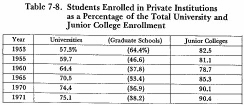- 現在位置
- トップ > 白書・統計・出版物 > 白書 > JAPAN'S MODERN EDUCATIONAL SYSTEM > (1)The Growth of Higher Education
(1)The Growth of Higher Education
While the university system was reorganized during the Occupation period, real expansion and development did not occur until after 1952. The 1960'S in particular witnessed the most rapid growth of the university system. Numerically, whereas there had been 226 universities and 228 junior colleges (tanki daigaku) in 1953, there came to be 389 universities and486 junior colleges by 1971. In terms of? students, the population attending universities (including graduate schools) increased to 1,468,538, or 3.3 times the 1953 student population, and in junior colleges to 275, 256, or 4.3 times the 1953 figure (See Table 7-6.). The percentage of students continuing onto university or junior college by 1971 increased to 26.8% of the corresponding age group; moreover, within the student population, the proportion of female students was steadily increasing (See Table 7-7.). The development of private universities and junior colleges is well illustrated by the sharp increase in the percentage of their enrolled students out of the total student population: students enrolled in private universities and junior colleges rose from 57.3% for universities and 82.5% for junior colleges in 1953 to 75.1%for universities and 90.4%forjunior colleges in 1971 (See Table 7-8-).
Table 7-6. Enrollment in Universities and Junior Colleges
Table 7-7. Female Students as a Percentage of the Total University and Junior College Enrollment

Table 7-8. Students Enrolled in Private Institutions as a Percentage of the Total University and Junior College Enrollment

The sudden burst in the expansion of higher education can be attributed to a number of mutually reinforcing factors. The establishment of the so-called "single-track" system, whereby graduates of all upper secondary schools were eligible for admission to universities, removed the institutional blocks that had so restricted access to universities in the prewar system. The economic and social development of the late 1950's also made it possible for many parents to l bear the expenses of higher education for their children. This same growth created increased social demand for the rapid development of scientific techniques and the expansion of science and engineering courses to train modern technologists. Corresponding changes were made within the university structure, particularly on the part of the private universities, to expand their facilities, stabilize their financial base and raise their public prestige in order to accommodate the increased number of students who wished to attend a university. The simplification of procedures for the establishment of new private universities, the rising prestige of many private universities, and their independent nature all greatly contributed to the rapid growth of this section in higher education.
お問合せ先
(C)COPYRIGHT Ministry of Education, Culture, Sports, Science and Technology
-- 登録:平成21年以前 --